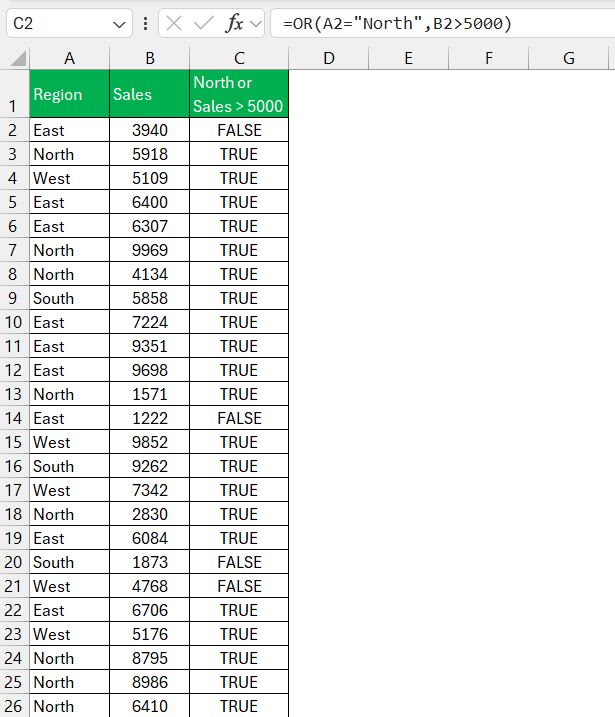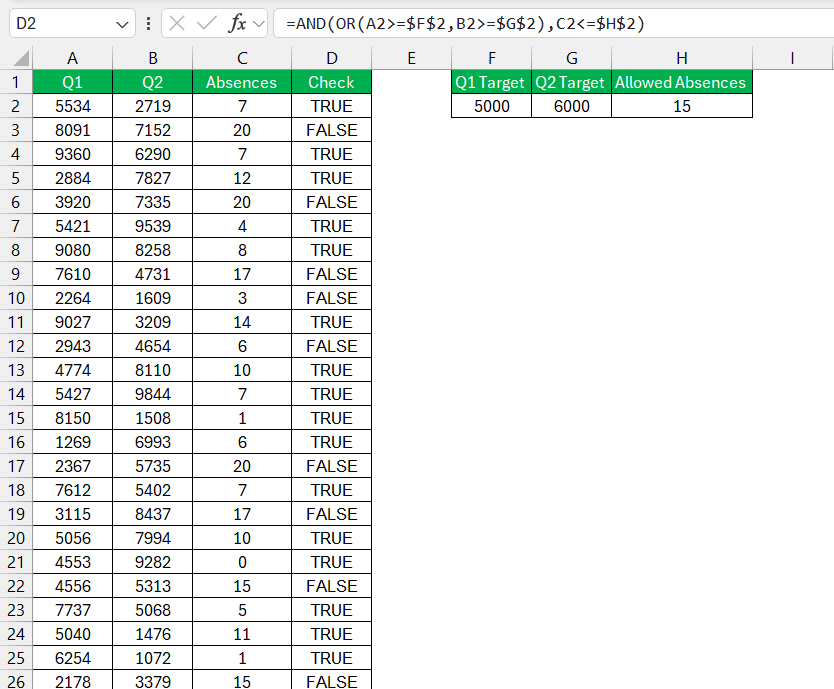The OR function in Microsoft Excel is a powerful tool for incorporating conditional logic into your spreadsheets, enabling you to assess multiple criteria simultaneously. By understanding how to effectively apply the OR function, you can transform your spreadsheets into dynamic, responsive, and efficient tools for analysis.
This quick guide aims to demystify the OR function, showcasing its versatility in various scenarios and providing insights on crafting smarter formulas.
Key Takeaways:
- Utilize the OR function to automate decisions, saving time and minimizing manual data evaluation.
- Apply the OR function across diverse tasks, from data validation to complex decision-making, to streamline workflows.
- Combine OR with functions like AND and IF for more complex logical operations, broadening your analytical capabilities.
- Ensure arguments are logical expressions and use parentheses to control the order of operations, maintaining formula accuracy and efficiency.
Table of Contents
Introduction to the OR Function in Excel
Unlocking the Potential of Conditional Logic
In Excel, the power to make smart and dynamic spreadsheets often lies in mastering conditional logic. The OR function is a fundamental part of this, allowing you to create formulas that can evaluate multiple conditions and make decisions based on the outcome.
But what does this mean for you? It means you can make your spreadsheets think and react, much like you would when analyzing a set of information.
How the OR Function Enhances Spreadsheet Efficiency
The OR function ramps up spreadsheet efficiency by streamlining decision processes. Imagine having to manually sift through rows of data to find certain values or conditions that meet your criteria – the OR function eliminates that grunt work.
By setting up criteria that can trigger a TRUE or FALSE response, you enable your spreadsheet to automatically determine outcomes, saving time and reducing human error. This can be particularly useful when dealing with large datasets where manual checking would be prohibitively time-consuming.
The Basics of the OR Function
Understanding the Syntax: The Building Blocks
Understanding the syntax of the OR function is like learning the basic rules of a game – once you know them, you can play much more effectively. The OR function’s syntax consists of a simple structure:
=OR(condition1, condition2, ...)
Let’s break this down:
OR: This is the function identifier.condition1, condition2, ...: Here, you can enter two or more conditions that you want to test for truth. The OR function checks each condition in the sequence and if any one of the conditions is TRUE, the function returns a TRUE value. If none are TRUE, it returns FALSE.
Remember, the conditions can be comparisons or references to other functions that return a logical value. Getting comfortable with this syntax is the first step in leveraging the full potential of the OR function to make your workbook smarter.
Common Uses for the OR Function in Daily Tasks
The OR function might seem simple at first glance, but its applications in daily tasks are vast. For example:
- Data Validation: Use the OR function to specify a set of valid inputs for a cell, ensuring data consistency.
- Conditional Formatting: Highlight cells that meet any of your specified criteria to quickly identify patterns or outliers.
- Complex Decision-Making: In financial models, use OR within IF statements to assign values or actions based on multiple conditions.
- Survey Analysis: Tally up responses that can be categorized into broader groups, when individual responses may vary but are still part of the same category.
- Scheduling & Planning: Check multiple cells against specific criteria to facilitate planning, such as room or resource bookings.
These uses illustrate how the OR function can simplify and enhance various routine tasks, leading to a more efficient workflow.
Crafting Smarter Formulas with the OR Function
Integrating the OR Function into Complex Formulas
Integrating the OR function into complex formulas can significantly expand the capabilities of your Excel worksheets. By chaining the OR function with other logical functions like AND, you gain the ability to create intricate logical tests.
For instance, suppose you want to check if a salesperson has achieved their target in either this quarter or the previous one, and also verify that they have not exceeded the number of allowed absences. This is a situation where you may use a formula that combines OR and AND functions:
=AND(OR(Q1_Sales >= Q1_Target, Q2_Sales >= Q2_Target), Absences <= Allowed_Absences)
By constructing formulas with these logical building blocks, you can evaluate complex scenarios within your data, making your assessment both thorough and efficient.
Remember to keep an eye on the order of operations when creating these formulas and use parentheses to group conditions logically. This ensures that Excel evaluates the formula correctly and yields the intended results.
Real-World Scenarios: OR Function in Action
The OR function can truly shine when applied to real-world scenarios across multiple industries:
- Human Resources: Manage employee benefits eligibility by setting multiple criteria for tenure, performance, or working hours.
- Sales Analysis: Monitor sales achievements by determining if sales figures meet any monthly or quarterly targets set for the team.
- Inventory Management: Alert management to reorder stock if quantities dip below certain thresholds during different times of the year.
- School Grading Systems: Automate student grade classification based on several passing criteria, such as test scores, attendance, and participation.
- Healthcare Scheduling: Validate the availability of practitioners and facilities using multiple criteria to ensure seamless patient appointments.
In each of these scenarios, the OR function helps to analyze diverse conditions, thereby enabling a responsive and efficient decision-making process.
Tips and Tricks for Using the OR Function Effectively
Avoiding Common Mistakes with the OR Function
When using the OR function, it’s important to sidestep a few common pitfalls to keep your formulas working flawlessly:
- Verify Logical Values: Ensure that every argument in your OR function is a logical test that can be evaluated as TRUE or FALSE. Non-logical inputs or incomplete comparisons can cause errors.
- Beware of Order of Operations: When combining OR with other functions, use parentheses to structure your formula correctly and avoid unexpected results.
- Avoid Overcomplication: Sometimes, less is more. Don’t complicate a formula with unnecessary OR statements if a single condition can do the job.
By being aware of and avoiding these common mistakes, you’ll maintain the integrity of your data analysis and make the most out of the OR function.
Optimization Strategies for Faster Calculations
When dealing with large datasets in Excel, calculation speed becomes crucial. To optimize the use of the OR function and keep your workbook running quickly:
- Limit the Number of Arguments: Only use as many conditions as necessary within the OR function to avoid excessive computation.
- Use Helper Columns: Break complex logic into simpler parts across multiple columns to help Excel process them faster and improve readability.
- Minimize Volatile Functions: Some functions recalculate every time a change is made in the workbook. Pair your OR function with less volatile functions where possible.
- Enable Automatic Calculation Settings: Ensure Excel is set to automatic calculation mode to optimize recalculation efficiency for the OR function and others.
- Consider Using Array Formulas: If applicable, array formulas can process multiple calculations simultaneously, speeding up the analysis.
Employing these strategies can contribute to more responsive spreadsheets, especially when dealing with data-heavy tasks.
FAQ: Mastering the Excel OR Function
What Exactly Does the OR Function Do in Excel?
The OR function in Excel evaluates multiple conditions, and if any one of them is TRUE, it returns TRUE. Otherwise, it returns FALSE. It’s perfect for scenarios where you’re checking if at least one of several criteria is met.
Can You Provide an Example of an OR Function Formula?
Certainly! Here’s a simple OR function formula example:
=OR(A1 > 10, B1 < 5)
This formula checks if the value in cell A1 is greater than 10 or if the value in cell B1 is less than 5. If either condition is met, it returns TRUE. If neither is met, it returns FALSE.
How Does the OR Function Interact with Other Functions Like AND and NOT?
The OR function can interact with the AND and NOT functions to build more complex conditions. With AND, all conditions must be true, while OR requires only one. NOT negates a condition. Together, they can fine-tune logical tests for specific needs.
Are There Any Limitations or Caveats When Using the OR Function?
Yes, the OR function only handles logical expressions, and issues can arise if arguments are not logical. Also, its use in array formulas or with too many arguments might slow down processing in large worksheets. Use it thoughtfully to maintain efficiency.
Where Can I Find More Advanced Tutorials on Using the OR Function?
For more advanced tutorials on using the OR Function, check out Excel’s official training resources, reputable online learning platforms like Lynda or Udemy, or specialized Excel forums and YouTube channels dedicated to spreadsheet education.
John Michaloudis is a former accountant and finance analyst at General Electric, a Microsoft MVP since 2020, an Amazon #1 bestselling author of 4 Microsoft Excel books and teacher of Microsoft Excel & Office over at his flagship MyExcelOnline Academy Online Course.









